
On Monday the Green MSP, Alison Johnstone, launched a public consultation on a Members Bill to introduce a ban on fox hunting and further restrict the killing of mountain and brown hares (see here). The Bill is partly in response to the failure of the Scottish Government to respond adequately to Lord Bonomy’s report into foxhunting which was published back in 2016. This identified a number of loopholes in the current law which has enabled fox hunting to continue. Alison Johnstone has added to this proposals to protect the mountain and brown hare year round, instead of part of the year as at present. The Bill would, however, still allow land managers to apply for licenses to cull foxes and hares for “pest control” purposes.
While in many ways very welcome, this post argues that the welfare approach which informs the Bill has its limitations and that what’s happening in our National Parks demonstrates we should be taking a much wider ecological approach. I will use the case of the Auchtertipper Native Woodland to illustrate the issues in respect of Mountain Hares.
Native woodland plantations, wildlife and people
Last year I went on Reforesting Scotland’s brilliant study tour to the north western part of the Cairngorm National Park (see here). One of the places we visited was the Auchtertipper native woodland plantation on the west side of the B9907 between Carrbridge and Forres.
The woodland provided a stark contrast to the burnt grouse moor behind (see above and below)
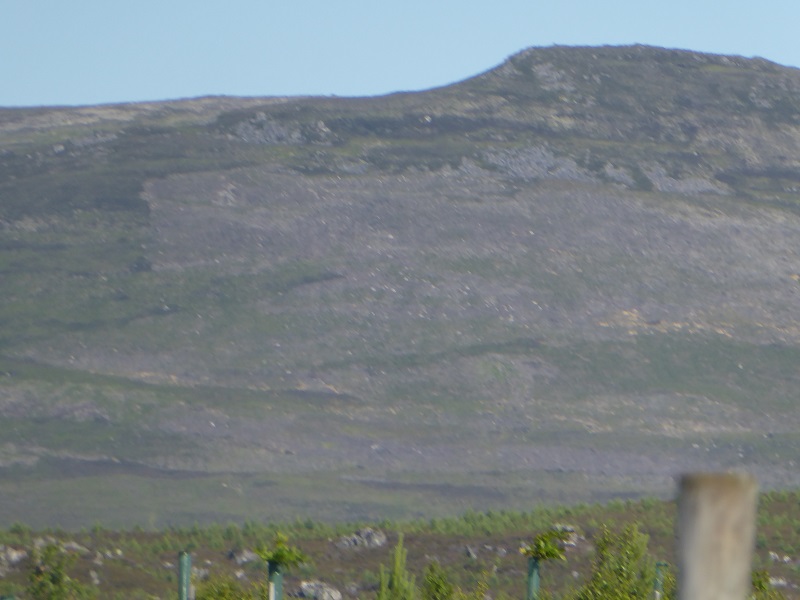
Within the native woodland plantation, the ground flora was flourishing, quite a contrast to the land around:
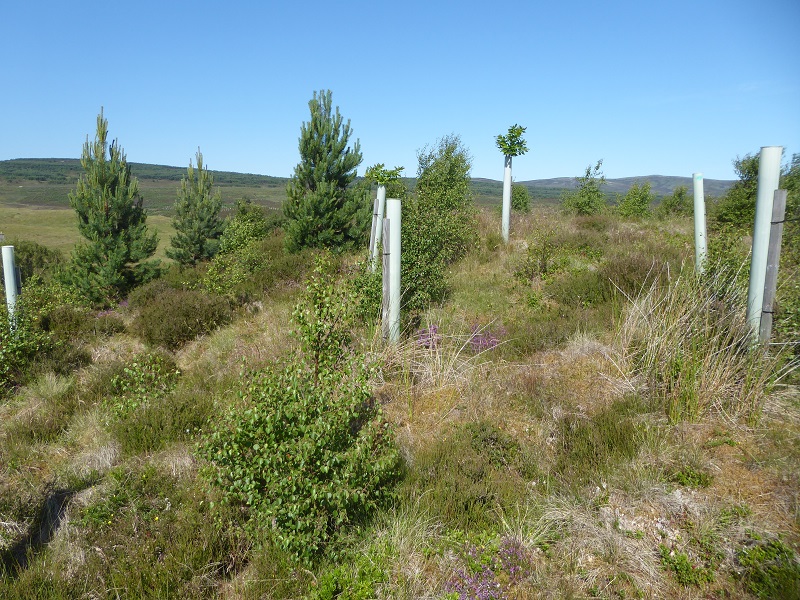
My initial reaction was that this is all very well but why are we allowing land in our National Parks still to be managed in parcels, paying landowners to enhance one area while allowing them to continue to mismanage the land round about? The fences around the woodland, which cost a fortune in public subsidy, with their batons to make them visible to black grouse provide graphic evidence of the ecological disconnect. That’s not the fault of the foresters but the landowners round about.
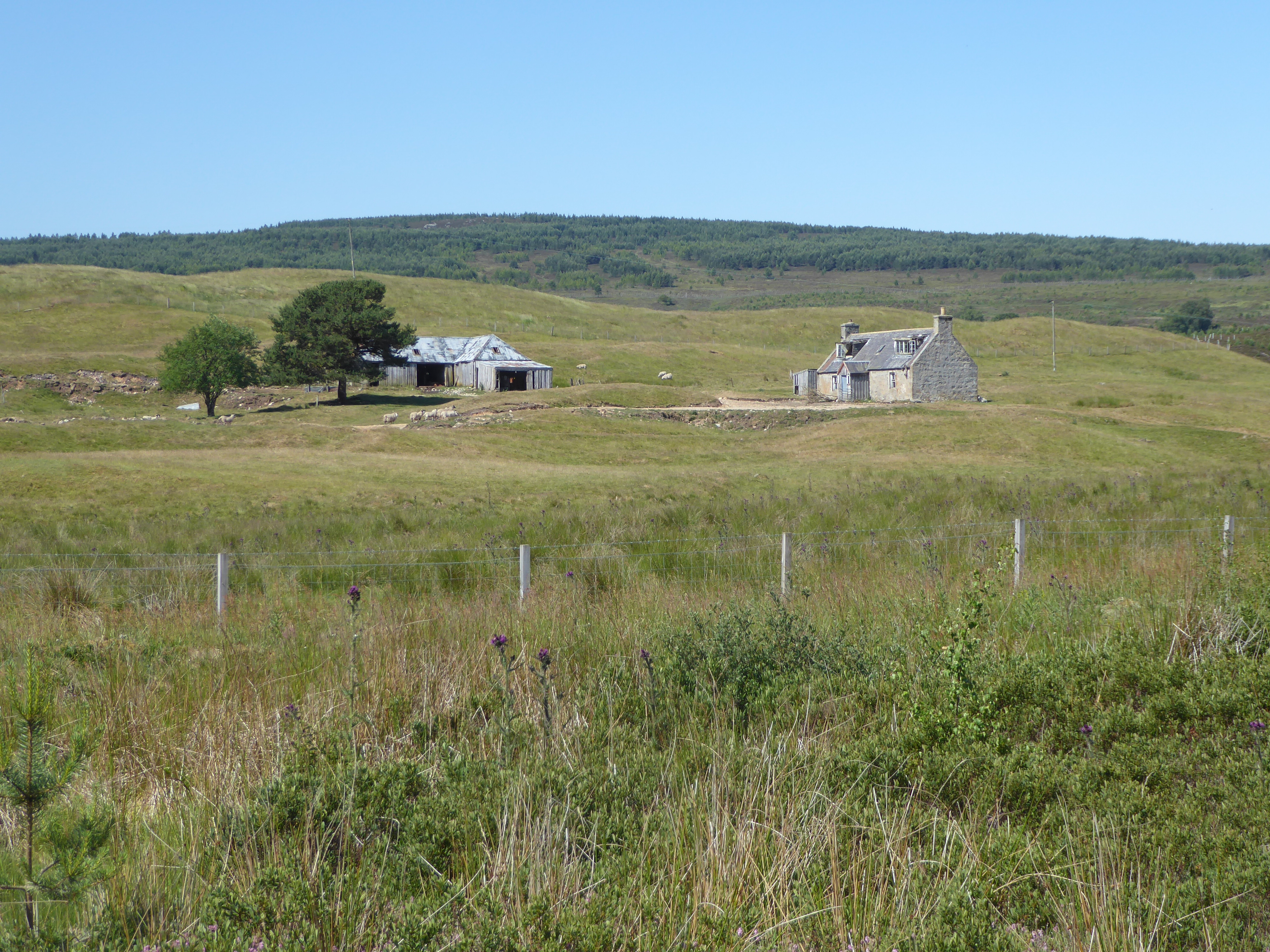
I also worried about the abandoned farm buildings in the centre of the woodland. Reforesting Scotland has rightly put people at the centre of forests but here we had a native woodland scheme which was being remotely managed. Why, I wondered, can’t such schemes be designed so they support rural employment? This could have made a great home for somebody.
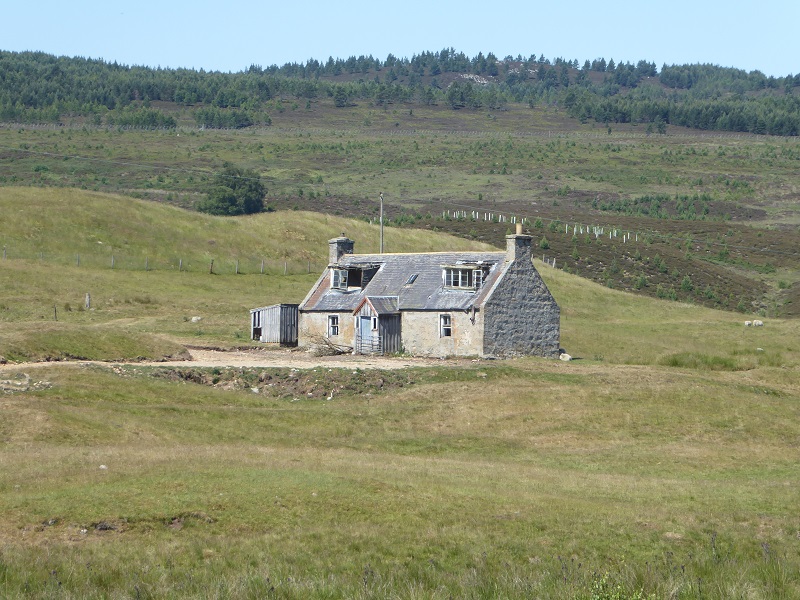
No wonder people who currently live in rural areas and work in agriculture are concerned that the Scottish Government’s reforesting agenda may herald a new wave of clearances from the land. That shouldn’t be necessary but unfortunately new native woodland schemes seem to be managed in just the same way as the industrial forestry plantations that have been responsible for the depopulation of rural Scotland including much of the Lomond and Trossachs National Park.
Cawdor Forestry, who currently manage the woodland, then described some of the challenges of getting the native woodland established, which included grazing by deer (which cross fences in the snow) and hares. Hence all the tree tubes. Cawdor Forestry also said they paid people to cull these animals.
My immediate response was why couldn’t that provide employment for a forester living in the abandoned house! I then looked over the fences and wondered how many weasels, stoats, foxes, eagles and hen harriers hunted over the grouse moor (which is located near a raptor persecution hotspot) and how far the hare “problem” was the result of their persecution.
Without predators hare numbers will explode if given a nutritious new food source. I did not, however, appreciate the full extent of the hare culls until several months later when I read Revive’s excellent report on Mountain Hare persecution in Scotland (see here)
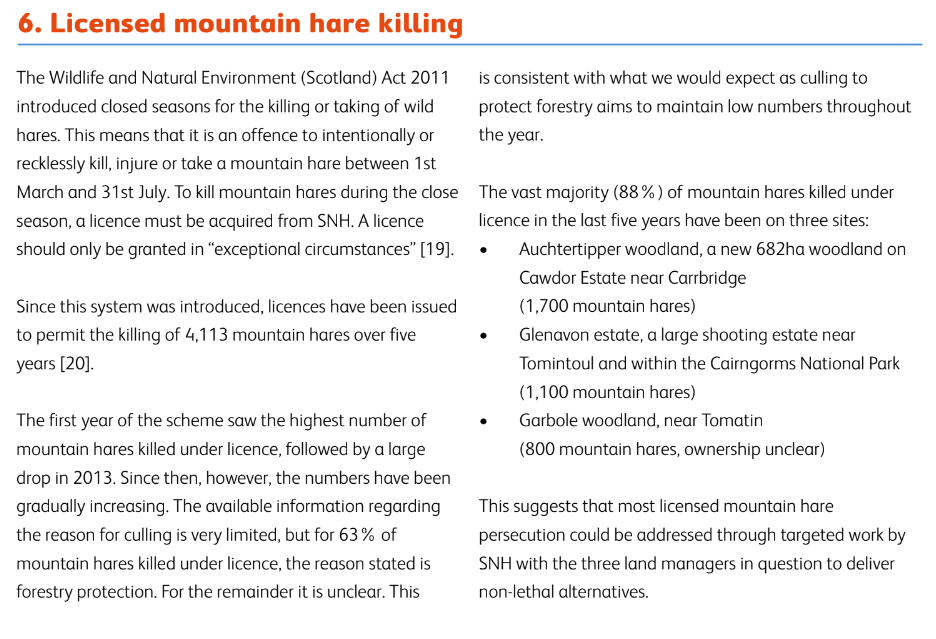
A staggering 1,700 mountain hares had been killed under license at Auchtertipper up until 2017, the most in Scotland.
I wish I had known this at the time of the visit. Why should the public purse be paying landowners to create native woodland in our National Parks without native animals?
There is a very interesting and detailed analysis of the Auchtertipper culls, which was written by a fields sports writer (see here), which is well worth reading for those who want to know more and shows that mountain hares were snared as well as trapped. (I strongly disagree with the writer’s conclusion, however, that grouse moors are better than woodland for mountain hares because there is less need to cull them in such quantities!)
Data from SNH shows a further license was issued in 2018 “for the killing of up to 130 mountain hare at Auchtertipper New Native Woodland Carrbridge Highland for the purpose of preventing serious damage to timber/crops. Methods permitted for killing are shooting during the day and shooting at night using lamps”. A further 125 hares were actually killed, so the slaughter continues.

The impact of Mountain Hares on woodland
From an ecological perspective mountain hares were one of the first mammals to colonise Scotland as the ice retreated and they didn’t stop a forest developing then. At that time, however, there were plenty of predators. Its seems a reasonable to suggest that mountain hare – like deer – will only prevent tree regeneration when their numbers reach certain levels in proportion to the tree seedlings and that this, in turn, will be determined by the number of natural predators.
There is some research which backs up the first part of this hypothesis. 20 years ago research on Mar Lodge (see here) concluded that the “extent of recorded browsing suggests that the impact of mountain hares on the establishment of Scots pine or birch woodlands in the uplands of Scotland would be minimal where hares occur at the moderate densities”.
In March this year the bio-diversity report published for the Werrity Review (see here for links), which has a section on mountain hares, reached a similar conclusion:
“We found little if any evidence to support the killing and population control of mountain hares to protect heather or other vegetation communities, but we note that browsing by mountain hares can suppress tree growth and woodland establishment. Where an alternative browse species such as heather is available, at low population densities mountain hares may not have large impacts on the establishment of native woodland. However, even at low to moderate densities browsing by mountain hares has the potential to supress tree growth and woodland establishment. There is limited available information in the published literature on the biodiversity impacts of browsing by mountain hares and effects on other sensitive vegetation, and the potential need for associated hare population control. There is also no substantive evidence of competition between grouse and mountain hares for forage, and any depletion of young heather will negatively affect mountain hares more than grouse. Similarly, except under unusual circumstances, there is no compelling evidence to support the population control of mountain hares as part of tick and/or Louping Ill Virus (LIV) control to benefit grouse.”
What neither piece of research considered was the entire web of nature or how the absence or presence of predators affects hare numbers and thus woodland generation. That is the ecological issue which I believe should be central to the debate on the protection of both brown and mountain hares. The problem is that so long as landowners can apply for special licenses for “pest control”, without any reference to the culling of predators in the surrounding area, the slaughter of hares is likely to continue and the real problem will not be addressed.
Closing the fox hunting ban loopholes may of course increase the number of foxes, though whether it will do so in our National Parks which are not renowned for traditional fox hunting is another question. It won’t, however, address the legal destruction of other mammalian predators like stoat and weasel.
Nor, I believe, will the current proposals in Alison Johnstone’s well intended Bill (see here for consultation document) prevent licenses being issued for “pest control” purposes. Here are the proposed licence conditions:
• Licences should not be issued unless the licensing authority is confident that there will be no negative impact on the local or national conservation status of the species in question.
• Licences should not be issued unless the licensing authority is confident that the proposed method and timing of killing will not have an unacceptable impact on animal welfare.
• Licences should not be issued where there is a risk that dependant young will suffer.
• Licences should be issued for specific purposes; these purposes should be stated in the legislation and should be purposes that are in the public interest – and outweigh the public interest of the protection that issuing a licence would override.
• Licences should not be issued unless they are a last resort measure and one to be used only when non-lethal measures have been shown to be ineffective.
• The licensing scheme should be transparent and publicly accountable56.
• Any use of a licence must be conditional on reporting how many animals have been killed/hunted and that they have been killed in accordance with the licence. This information should be published by the licensing authority.
• Licensing should be run on a full cost-recovery basis.
There is nothing in this that addresses, or even requires an assessment of, the presence of predators which might keep hare numbers under control and prevent the need for culling.
What needs to happen
Mountain hares are ostensibly being shot for several reasons: for sport; because they are perceived to pass on disease to red grouse; and because of their impact on young woodland. Alison Johnstone’s Bill is for the whole of Scotland and will effectively prevent mountain hares being shot for sport or reasons associated with grouse moor management. Old statistics suggest that could cover 90% of all hare culling. As the more recent Auchtertipper statistics show, however, considerable numbers are now also being killed in woodland. The statistics only cover hares killed under license in the closed season. The vast majority of hares shot in woodland are likely to be killed in the open season.
While this post has focussed on mountain hares, data obtained by Alison Johnstone through an FOI request, and revealed by the Ferret (see here) shows a significant number of licenses have also been issued to kill brown hares. At least two of those licenses were issued for land in the Cairngorms National Park, on the Rothiemurchus Estate and the adjacent Ord Ban Plantation.
It seems quite predictable that IF the Bill gets passed in its present form, the number of license requests for “pest control” for both mountain and brown hares will increase dramatically unless a more holistic ecological approach is taken. I would hope that people responding to the Bill can suggest ways to prevent “pest control” becoming a new loophole in the law. Its quite easy to imagine land managers, prevented from culling mountain hares for grouse moor management purposes, suddenly because adherents of native woodland natural regeneration and claiming mountain hares are what is preventing this. That could, as the proposed legislation is worded, allow grouse moor managers to cull under license as many hare as they do at present.
Our National Parks, however, could and should be taking the lead on implementing a more ecological approach. There is no reason, for example, why they should not use their conservation byelaw making powers to protect the other native mammalian predators, besides foxes, that prey on hares – stoats and weasels. They could also start publishing records of such predators in both our National Parks and start mapping their presence against hare numbers. In other words they could start contributing to the debate and the actions required to protect our native species instead of sitting on the sidelines as at present.
Why can`t the government just confiscate these estates, because this kind of practise should never be allowed in a national park. Pity the Danish chap who owns the Glen Feshie estate has`t been copied by the rest of these landowners.
One only has to walk in the Wells of Lecht area or Glen Gairn to save wear and tear on boots . You walk around there on a fur carpet of dead hares. Not even picked up to eat and numbers in excess of age and/or winter deaths . If you had asked me forty years ago I would have said that Grouse shoots were vital to the rural economy but not now . I live in Wales and saw how much the economy relied on outdoor pursuits visitors during the Foot and Mouth epidemic Economically there are more people coming to see the environment and fauna than the proportion who come to shoot it. As for joined up thinking on forestry on the common good / health benefits / access – versus – profits arguments we have lost the plot . I am off to see if I can sign up to support the Alison Johnstone Fox and Hare Bill in the hopes that some good will come of it